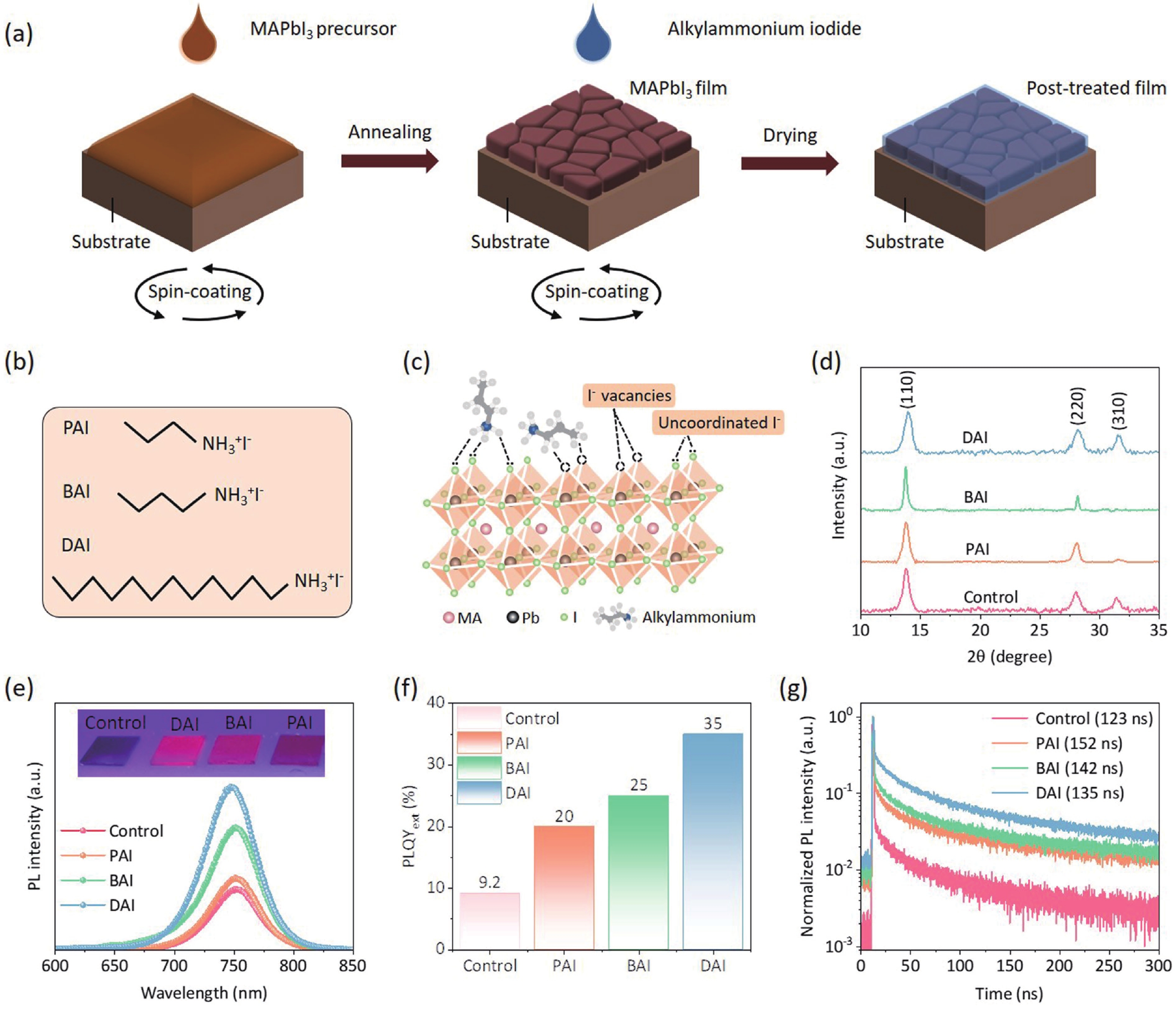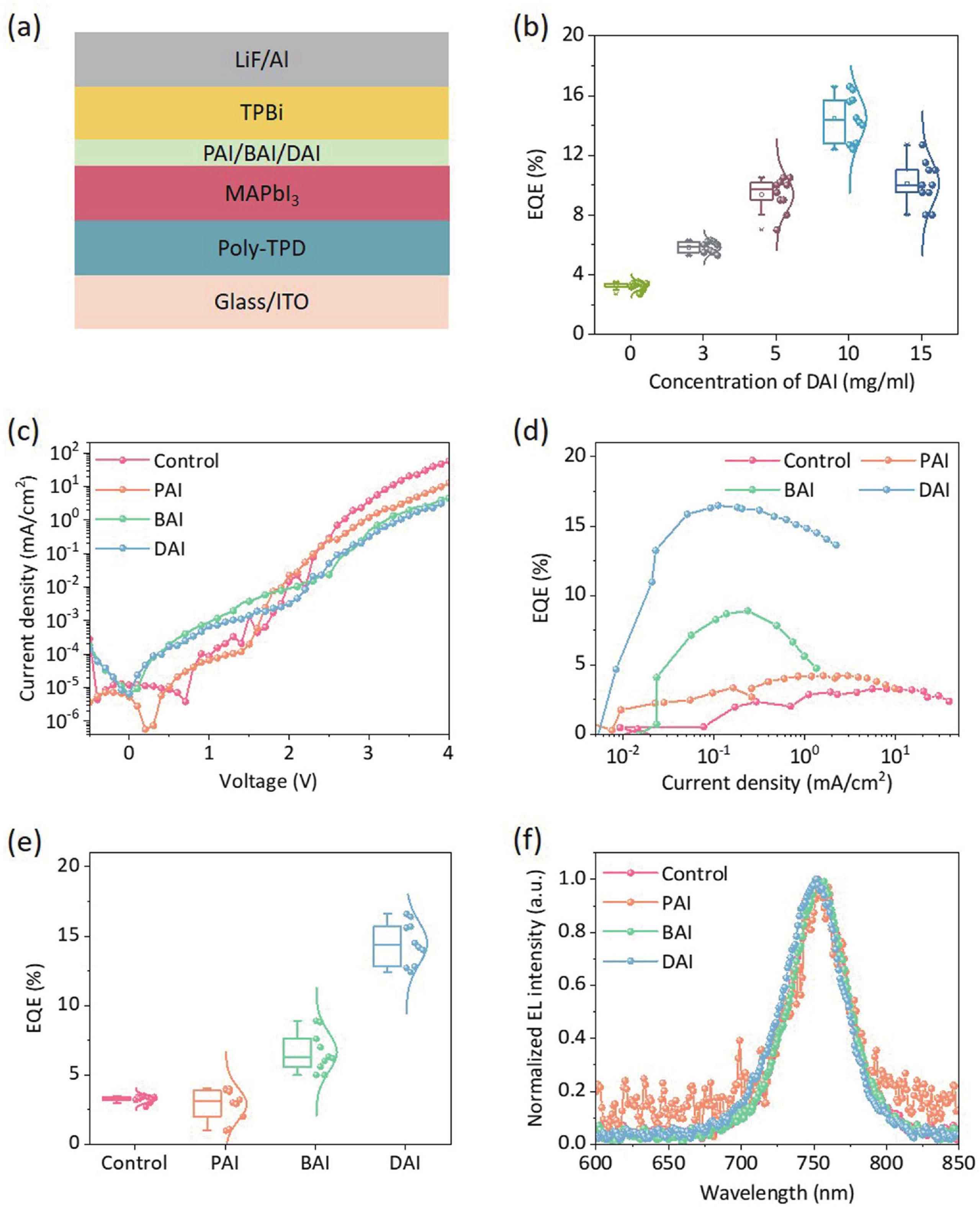Metal-halide perovskites (MHPs) have emerged as a new class of semiconductors used in perovskite solar cells (PSCs)[1−5], perovskite light-emitting diodes (PeLEDs)[6−12], photo/X-ray detectors[13−16], and memristors[17, 18]. PeLEDs can emit different light with high purity[19, 20]. Over the past few years, the external quantum efficiency (EQE) has been rapidly increased from less than 1% to above 28% due to the intensive research efforts in composition engineering, device structure optimization and defect passivation[21−23]. Interface defects passivation is useful for developing efficient and stable PeLEDs[24]. Alkylammonium salts exhibited strong passivation function due to the chemical interaction between ammonium and [PbI6]4− octahedron[25, 26]. The alkyl chain length is a critical factor in defect passivation[27], which has been demonstrated in perovskite solar cells[28]. In this work, we thoroughly examined the functions of alkylammonium iodide with tunable alkyl chain lengths (propyl ammonium iodide (PAI), butylammonium iodide (BAI), and dodecylammonium iodide (DAI)) in passivating defects of the interface between MAPbI3 emission layer and the electron-transport layer (ETL). We found that the passivation function intensifies with increasing alkyl chain length. The EQE reaches 16.5% when the emissive layer is post-treated by DAI with longer chain.
MAPbI3 film fabrication and subsequent post-treatment are shown in Fig. 1(a). Because of the low-temperature synthesis and crystallographic features of perovskite, numerous defect sites, especially I− defects and delocalized organic amine defects, exist on perovskite film surface and grain boundaries[29−32]. These defect sites act as the recombination centers, limiting the device performance. To passivate these defects, the perovskite layer was post-treated by spin-coating a thin layer of alkylammonium salt, then followed by heating.

Fig. 1(b) depicts the chemical structures of alkylammonium iodides, which consist of the same end groups but different alkyl chains. Fig. 1(c) illustrates the alkylammonium-passivated perovskite lattice. The alkylammonium iodides coated on the perovskite layer fill the iodine vacancies and passivate uncoordinated iodine defects on the surface through ionic and hydrogen bonding[25, 26]. X-ray diffraction (XRD) results show no additional diffraction peaks after post-treatment (Fig. 1(d)). The scanning electron microscopy (SEM) images for the perovskite films also exhibit negligible differences in surface morphology before and after post-treatment (Fig. S1). Those little change in lattice structure and grain size after surface treatment indicate no grain growth or dissolution by post-treatment.
Afterward, we compared the optoelectronic properties of the control and post-treated perovskite films to evaluate the passivation ability of PAI, BAI, and DAI, respectively. Fig. 1(e) shows the photoluminescence (PL) spectra of the films, showing increase in peak intensity as alkyl chain length increases. The slight blue-shift of PL peaks was observed in the film with post-treatment, which can be attributed to the reduction of defect density for the film[33, 34]. The photo images for the films under UV light can confirm these results (inset of Fig. 1(e)). Furthermore, we conducted the external-photoluminescence quantum yield (PLQYext) and time-resolved photoluminescence (TRPL) measurements to examine the impact of post-treatment on carrier recombination dynamics (Figs. 1(f) and 1(g)). The average carrier lifetime (Taverage) and PLQYext values for the post-treated films increased significantly compared to the control film (Table S1). The control film has a Taverage of 123 ns and a PLQYext of 9.2%, while the films post-treated with PAI, BAI, and DAI showed bigger Taverage values of 152 ns, 142 ns, and 135 ns, respectively. In addition, the PLQYext values for the post-treated films increased substantially, with values of 20%, 25%, and 35% for PAI, BAI, and DAI cases, respectively. We further calculate the radiative (Krad) and non-radiative (Knonrad) recombination rates by using the equation 1Taverage=Krad+Knonrad and PLQYext=KradKrad+Knonrad. The Knonrad value reduced from 7.3 × 106 s−1 for the control film to 4.8 × 106 s−1 for DAI-treated film (Table S1). This reduction of the non-radiative recombination losses indicates that the alkylammonium iodides with longer chain reduce more surface defects[25, 35].
The improved optical properties for MAPbI3 films with post-treatment enable us to fabricate efficient PeLEDs. The device structure with post-treatments is shown in Fig. 2(a). To determine the ideal concentration of alkylammonium iodides, we made PeLEDs with post-treatments by using different concentrations of DAI. A DAI concentration of 10 mg/ml led to a higher EQE. Therefore, we fixed the concentration of alkylammonium iodides at 10 mg/ml for post-treatments (Fig. 2(b)). Figs. 2(c) and 2(d) show the J−V and EQE curves of PeLEDs. The EQE increases dramatically from 3.3% (control) to 4.2% (PAI), 8.9% (BAI), and 16.5% (DAI). The EQE for DAI case is the highest. The EQE statistics based on 10 devices show very small variations, indicating good repeatability (Fig. 2(e)). Fig. 2(f) shows the electroluminescence (EL) spectra for control device and post-treated devices, being consistent with PL spectra.
In short, we realized the interface passivation of perovskite films by using a series of alkylammonium iodides with different alkyl chain lengths. Longer alkyl chain favors defects passivation and device performance. The PeLEDs with DAI layer gave an EQE of 16.5%.
Acknowledgements
We thank the National Natural Science Foundation of China (62234004, 62175226), the National Key Research and Development Program of China (2022YFA1204800), the University Synergy Innovation Program of Anhui Province (GXXT-2022-009), and the China Postdoctoral Science Foundation (2022M723006). L. Ding thanks the National Key Research and Development Program of China (2022YFB3803300), the open research fund of Songshan Lake Materials Laboratory (2021SLABFK02), and the National Natural Science Foundation of China (21961160720).
Appendix A. Supplementary material
Supplementary materials to this article can be found online at https://doi.org/10.1088/1674-4926/44/12/120501.




 DownLoad:
DownLoad:


 DownLoad:
DownLoad:











 Rashid Khan is currently a PhD student at the Department of Physics, University of Science and Technology of China (USTC). He obtained his MS degree from the International Islamic University Islamabad, Pakistan in 2016. His current research focuses on the interface engineering of perovskite LEDs
Rashid Khan is currently a PhD student at the Department of Physics, University of Science and Technology of China (USTC). He obtained his MS degree from the International Islamic University Islamabad, Pakistan in 2016. His current research focuses on the interface engineering of perovskite LEDs Guangyi Shi got his BS degree from Soochow University in 2021. Now he is a Master student at the University of Science and Technology of China under the supervision of Prof. Zhengguo Xiao. His current research focuses on large-area perovskite LEDs
Guangyi Shi got his BS degree from Soochow University in 2021. Now he is a Master student at the University of Science and Technology of China under the supervision of Prof. Zhengguo Xiao. His current research focuses on large-area perovskite LEDs Wenjing Chen got her PhD from Department of Physics, University of Science and Technology of China (USTC) in 2022. Now she is a postdoc at USTC. Her research focuses on perovskite materials and devices
Wenjing Chen got her PhD from Department of Physics, University of Science and Technology of China (USTC) in 2022. Now she is a postdoc at USTC. Her research focuses on perovskite materials and devices Zhengguo Xiao got his PhD from University of Nebraska-Lncoln in 2015. After 3-years postdoc at Princeton University, he joined Department of Physics, University of Science and Technology of China, as a professor. His research focuses on perovskite LEDs, solar cells, and detectors
Zhengguo Xiao got his PhD from University of Nebraska-Lncoln in 2015. After 3-years postdoc at Princeton University, he joined Department of Physics, University of Science and Technology of China, as a professor. His research focuses on perovskite LEDs, solar cells, and detectors Liming Ding got his PhD from University of Science and Technology of China (was a joint student at Changchun Institute of Applied Chemistry, CAS). He started his research on OSCs and PLEDs in Olle Inganäs Lab in 1998. Later on, he worked at National Center for Polymer Research, Wright-Patterson Air Force Base and Argonne National Lab (USA). He joined Konarka as a Senior Scientist in 2008. In 2010, he joined National Center for Nanoscience and Technology as a full professor. His research focuses on innovative materials and devices. He is RSC Fellow, and the Associate Editor for Journal of Semiconductors
Liming Ding got his PhD from University of Science and Technology of China (was a joint student at Changchun Institute of Applied Chemistry, CAS). He started his research on OSCs and PLEDs in Olle Inganäs Lab in 1998. Later on, he worked at National Center for Polymer Research, Wright-Patterson Air Force Base and Argonne National Lab (USA). He joined Konarka as a Senior Scientist in 2008. In 2010, he joined National Center for Nanoscience and Technology as a full professor. His research focuses on innovative materials and devices. He is RSC Fellow, and the Associate Editor for Journal of Semiconductors







